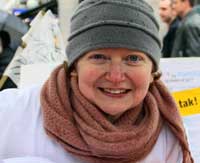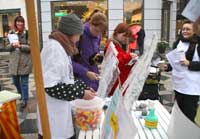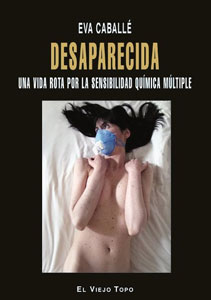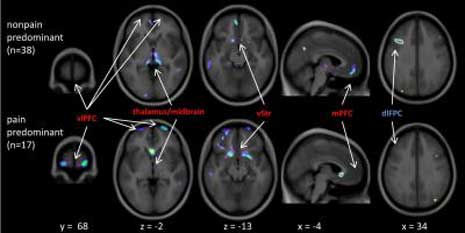MCS – Multiple Chemical Sensitivity: A Report from Denmark
 Hi, my name is Mette Toft. I’m 53 years old, married and blessed with two grown-up children. I have a university degree (MA) in Japanese and Danish and was teaching these languages, at universities and language schools, for many years. Inspired by my diligent students, I even came up with a new, simple way of teaching Danish pronunciation and had teaching material for students and teachers published. I always thought I hated phonetics, but this project was great fun!
Hi, my name is Mette Toft. I’m 53 years old, married and blessed with two grown-up children. I have a university degree (MA) in Japanese and Danish and was teaching these languages, at universities and language schools, for many years. Inspired by my diligent students, I even came up with a new, simple way of teaching Danish pronunciation and had teaching material for students and teachers published. I always thought I hated phonetics, but this project was great fun!
Increasingly, though, I had health problems that no doctor could explain: headaches, rashes, fatigue and malaise.
Perfume allergy, MCS and lupus
In 1999 a patch test showed that I was highly allergic to perfume. My dermatologist told me to take this very seriously. If not, it might progress to a point where I couldn’t be in the same room with people who were wearing perfume, she explained. From that day on, our home was completely fragrance free. At work, however, and everywhere else I went, I was still surrounded by perfume and scented products of all kinds. So, alas, the dermatologist’s prediction came true, with a vengeance.
In 2005 I became seriously ill with what turned out to be MCS and lupus (a really troublesome and potentially fatal autoimmune disease) – simultaneously. It soon became clear that I would have to stop working. Nevertheless, for four years, I was denied any kind of social benefits. This is a pretty common practice in Denmark, I’m sorry to say.
A happy happening in a sad setting
Here I would like to tell you about our MCS-happening in the heart of Copenhagen on 12 May, The International MCS Awareness Day, and, not least, about the sad setting of this cheerful event.
In Denmark, as in many other countries, MCS is not yet recognised as a true physical disease caused by chemicals. The Danish  National Board of Health maintains that MCS is not a disease, but a “situation” where people “believe” or “feel” that various airborne chemicals are making them ill. Accordingly, MCS patients are sometimes referred to psychiatrists to be misdiagnosed with a psychiatric diagnosis, typically “somatoform disorder”, which means “all in the head”.
National Board of Health maintains that MCS is not a disease, but a “situation” where people “believe” or “feel” that various airborne chemicals are making them ill. Accordingly, MCS patients are sometimes referred to psychiatrists to be misdiagnosed with a psychiatric diagnosis, typically “somatoform disorder”, which means “all in the head”.
The Danish Research Center for Chemical Sensitivities on the lookout for ”psychological factors” in MCS patients
In 2006 The Danish Research Centre for Chemical Sensitivities was established on the initiative of the Danish Ministry of the Environment. It soon became evident that the purpose of this research center was to have the environment acquitted, so to speak, of the charge of causing MCS. Time and again patients heard the then Head of Research, MD, PhD Jesper Elberling announce that the environment should probably not be blaimed for the problems.
The Research Center has no experts of toxicology or environmental medicine among its staff. Instead, the new Head of Research, former nurse, MSc, PhD Sine Skovbjerg and her staff focus on counting and documenting various ”psychological factors” among patients. Her view is that MCS should be studied as a somatoform disorder and that MCS can be cured by so-called mindfulness-based cognitive therapy.
Which psychological factors do you have? – None. I have MCS.
Shocking news about electroconvulsive therapy (ECT) as a treatment for MCS
I think it is fair to say that the international MCS community was shocked when the aforementioned Jesper Elberling published an article in which he concluded that: “Electroconvulsive therapy should be considered an option in severe and socially disabling MCS…”. Elberling has elsewhere stated that: “If the observations concerning ECT are correct, then it means that we can be VERY (sic) optimistic about a future treatment for MCS”. Obviously, not many Danish MCS patients share this view.
An abstract of the article and international reactions to it is found at Canary Report:
Psychiatrists propose induced convulsions as treatment for Multiple Chemical Sensitivity
Counter action
 In an attempt to cheer ourselves up a bit in the midst of this depressing madness, we decided to celebrate The International MCS Awareness Day on May 12 with a colourful and festive happening in the heart of Copenhagen.
In an attempt to cheer ourselves up a bit in the midst of this depressing madness, we decided to celebrate The International MCS Awareness Day on May 12 with a colourful and festive happening in the heart of Copenhagen.
Unfortunately, the rain was pouring down all day long and a few of our attractions – a couple of  spectacular canary costumes among them – had to be left out of the programme and saved for a hopefully sunnier MCS Awareness Day next year. Our MCS-lottery and free samples of fragrance free skin cremes did appeal to quite a lot of people, though, and each and everyone of them took a copy of our information sheet and MCS-folder home to read.
spectacular canary costumes among them – had to be left out of the programme and saved for a hopefully sunnier MCS Awareness Day next year. Our MCS-lottery and free samples of fragrance free skin cremes did appeal to quite a lot of people, though, and each and everyone of them took a copy of our information sheet and MCS-folder home to read.
A student who had decided to do a paper on MCS came early to ask questions. And one concerned politician (of the 60 or so who were invited) dropped by for a serious chat.
Author: Mette Toft, Denmark
© Photos: Torben Bøjstrup
Further Reports about the Situation of MCS Patients in different Countries:
- MCS in Japan – A Lecture at the House of Representatives of Japan
- Multiple Chemical Sensitivity recognized as physical disease at ICD-10 in Japan
- Spanish Workgroup met with Ministery of Health to create a MCS Consensus Document
- Italian Parties united under MCS cause
- The Department of Health of the Austrain Government recognizes MCS as a physical Disease
- German federal institute for occupational safety and occupational medicine mentioned Multiple Chemical Sensitivity at Thesaurus Safety and Health at Work
- MCS registered as physical disease at ICD-10 in Germany






